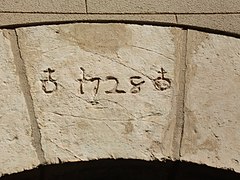♁
Hello, you have come here looking for the meaning of the word ♁. In DICTIOUS you will not only get to know all the dictionary meanings for the word ♁, but we will also tell you about its etymology, its characteristics and you will know how to say ♁ in singular and plural. Everything you need to know about the word ♁ you have here. The definition of the word ♁ will help you to be more precise and correct when speaking or writing your texts. Knowing the definition of♁, as well as those of other words, enriches your vocabulary and provides you with more and better linguistic resources.
 | ||||||||
| ||||||||
Translingual
Alternative forms
(alchemy): 🜱 (for regulus of antimony / antimony metal)
Etymology
(Christianity, astronomy): A globus cruciger (the globe surmounted by a Christian cross), representing Christ's or the Church's rule over the redeemed world. Alchemical extension to newly-discovered antimony, motivated by an attempt to retain an association between the basic metals and the known planets. Astronomical use is reinforced by the graphic similarity to the symbol ⟨♀⟩ for Venus, which is the planet that is most similar to Earth.
Symbol
♁
- (astronomy) the planet Earth.
- (Christianity) the redeemed world (a symbol that was carried by depictions of Jesus and medieval Christian kings).
- (cartography) marks a church.
- (alchemy) stibnite (antimony ore, Sb2S3).
- (astrology, rare) the fictitious planet Proserpina, which one Polish school of astrology identifies as the dwarf planet Eris.
Usage notes
In contemporary astronomy, ⟨♁⟩ is particularly common in German-language sources. ⟨🜨⟩ is the usual symbol in English-language sources, but ⟨♁⟩ also occurs.[1]
Synonyms
- (astronomy, Christianity): 🜨
- (astrology): ⯘, ⯰, ⯱
- (alchemy): 🜰 (regulus of antimony / antimony metal)
Derived terms
- (astronomy): M♁ – Earth mass (as a unit of measurement).[2]
- (astronomy): R♁ – Earth radius (as a unit of measurement).
- 🜫 – antimony ore.
- 🜭 – antimony salt.
- 🜥 – copper antimoniate.
Gallery
-
A banded globus cruciger
-
As a Christian symbol on a date
(♁ 1728 ♁ = 1728 AD) -
As a planetary symbol on a plaque
-
Transit of Earth
Related terms
See also
- ⏚ (ground)
References
- ^ E.g. Beutler, Mervart & Verdun (2006) Methods of Celestial Mechanics, volume II: Application to Planetary System, Geodynamics and Satellite Geodesy
- ^ E.g. A. G. G. M. Tielens (2021) Molecular Astrophysics, CUP, p. 10;
Boblest, Müller & Wunner (2015) Spezielle und allgemeine Relativitätstheorie, p. 19.
Latin
Noun
♁ n (genitive ♁niī); second declension
- (alchemy) Abbreviation of antimonium (“antimony”).
- 1701, Johann Christoph Sommerhoff, Lexicon pharmaceutico-chymicum latino-germanicum & germanico-latinum [Pharmaceutico-Chemical Lexicon, Latin-German and German-Latin], page 69:
Declension
Second-declension noun (neuter).



